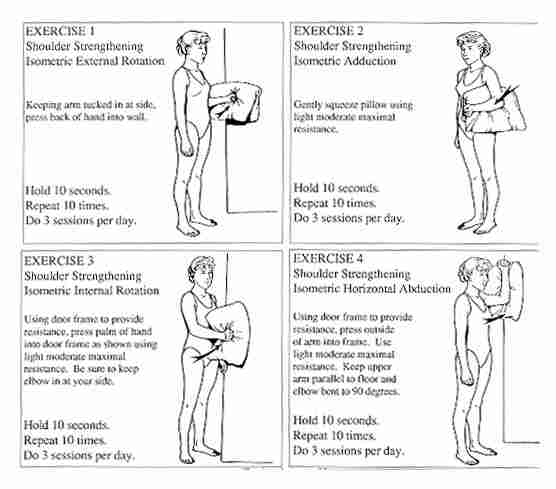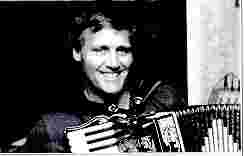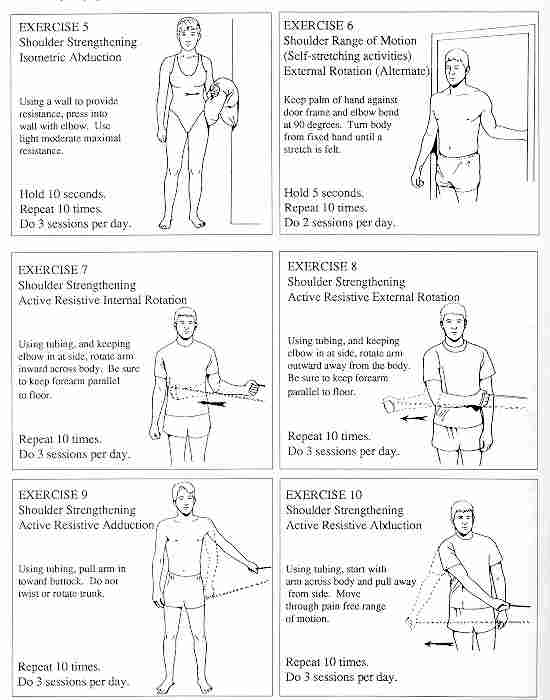
 This article has been prompted by several accordionists who have called or
written me requesting advice about exercises to increase endurance or
strengthen shoulders and arms following injury or debility because of the
long lay-off in playing. My advice to those who have had upper extremity
injuries is to seek medical help and appropriate rehabilitation from their
medical doctor, who can guide them to the best qualified medically
approved source for physical recovery.
This article has been prompted by several accordionists who have called or
written me requesting advice about exercises to increase endurance or
strengthen shoulders and arms following injury or debility because of the
long lay-off in playing. My advice to those who have had upper extremity
injuries is to seek medical help and appropriate rehabilitation from their
medical doctor, who can guide them to the best qualified medically
approved source for physical recovery. However, playing the accordion has its specific challenges and needs physically, which generally is poorly understood by medical personnel who are not accordionists and are thus likely to give you the standard advice "if it hurts don 't do it." This is not what accordionists want to hear! I often am told by those players who are plagued by back or neck problems that their doctors (or chiropractors) have insisted they don't play.
What the good doctors don't explain fully is that in most cases it is not the act of playing the accordion that is a possible source of irritation. Rather, it is the fact that one is sitting! Sitting is a real challenge and primary source of aggravation to the low back. The accordion plays no part in this as it is strapped on close to the body and is balanced on the upper thighs. There is absolutely no increase in low back pressure when the accordion is balanced in a proper playing position. (Unless you are one of those few who wears their accordions half-way down their chests!)
The only detriment to playing with a painful or stiff low back is 1) sitting to play and 2) the act of taking the instrument out of its case. A word of caution: standing up to play does put a considerable loading on the low back and the neck and shoulders and should be avoided whenever possible.
With regard to the neck, a properly positioned accordion poses no problem if one is not standing and if the accordionist keeps his or her head up by positioning the music stand at eye level height and does not constantly strain to look at the keyboard while playing. Make sure also that you have wide, well padded straps over the shoulders. A good set of well-made straps is a sound health investment. It goes without saying that many professional accordionists who perform standing up eventually have trouble with their necks ranging from stiffness and headache to the more serious numbness and tingling in the hands and fingers that arises from nerve compression in the lower neck. If you experience tingling in the fingers, seek your doctor's advice quickly. In a future article, I shall discuss the different types and distribution of numbness and tingling that can occur so that. you will understand what may possibly be causing it.
To get back to helping you get strong in the shoulders and arms following surgery, injury, or general weakness after a long lay-off, I have some general exercise programs which you can perform at home. Or perhaps you would like to increase your strength and endurance to better master bellows technique and improve control of your accordion. These exercises will also do that.
There are two objectives built into the program of exercises that follows this discussion.
2) To work toward building strength and endurance, not muscle bulk like a weight lifter. To achieve, this keep in mind that the key is to do lots of repetitions with a low weight or resistance if exercising with upper body equipment like wall pulleys or gymnasium equipment at a health club. If you have a special problem, write to me and I will do my best to point you in the right direction.
Most strength and endurance is required in the left shoulder and arm because of bellows action. To pull the bellows out we use two main muscle groups. The hard working shoulder external rotators, for example, infraspinous muscle and secondarily the shoulder abductors (moving away from the body) like supraspinatus and the deltoid muscle. Keep in mind that many other muscles also work to stabilize and support the head, neck and upper body while this action is taking place.
To push the bellows in we use the strong latissimus dorsi muscle and the pectorals mainly as well as the internal shoulder rotators of which the subscapularis muscle is the most important.
For the right hand, good strength and endurance must be preserved to sustain the proper shoulder-arm-wrist position. The main group for this is the shoulder abductors namely deltoid, and secondarily supraspinatus. The deltoid muscle is easy to find. Place your hand over the outside upper-most part of your shoulder joint. Now lift your arm away from your side. You will feel the deltoid muscle fibers contract. With sustained playing, deltoid is required to remain contracted for a long period of time. Fortunately, this muscle is seldom injured, but it can become weak through non -use or debilitation. It is a very important muscle for the right hand keyboard.
Here are a collection of do-it-yourself exercises with suggested repetition rates, which should help you improve strength and endurance, to assist you in managing the accordion. Remember, start out slowly and gently, building repetitions gradually. Any questions, please write to me care of Accordion World, 16323 S.E. Stark, Suite 2, Portland, OR 97233. Good luck!


Reprinted from Accordion World, (Portland, Oregon: June 1994). Used with permission.
The Classical Free-Reed, Inc. staff gratefully acknowledges
volunteer Terry Knight who assisted in the production of this
article.
Born in New Zealand in 1942 of Italian parents, he grew up in a musical
family in which his grandfather played accordion. Mr. Bonica played
drums, percussion, flugelhorn, bugle and string bass before turning to the
accordion at age 15. He taught himself by ear and learned the Chopin
"Minute Waltz" by listening to a recording by Charles Magnante.
After some time, he realized the limitations of playing only by ear, so he
taught himself how to read music so he could enter competitions. He won
the New Zealand Championship several years in the duet, trio and quartet
divisions. He won second place at the New Zealand Open in 1978 in the solo
division.
Mr. Bonica emigrated to the United States in 1980 to teach spinal
specialists and continue his practice of spinal therapy. He has recorded
four CDs of Italian and European folk music utilizing a MIDI orchestra
ensemble. Other activities include writing and publishing (he was editor
and publisher for Accordion World magazine from 1989 until 1994),
sailing and photography.
Part Six:
Special Instructions for Low Back Patients
by
John Bonica, L.P.T., N.Z.R.P.Part Seven: The
Great Accordion Myth!
Is Lighter Really
Better?
by John Bonica, L.P.T.,
N.Z.R.P.
Invitation to Contributors / Submission
Guidelines Back to The Free-Reed Journal
Contents Page Back to The Classical Free-Reed,
Inc. Home Page